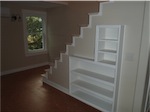First, it must be well-sealed with a non-toxic sealer. I used Ikea’s, which because of the stringency of European chemical standards, I trust.
The sealer should be re-applied with some regularity – quite frequently in the first weeks or months after installation. We have not been as virtuous about this as we might have been, but we’re still happy with the results.
I thought most people knew this, but my husband proved me wrong: it’s not a good idea to leave a damp metal can sitting on a wooden surface. It will stain. The good news, it is fixable. (You stain it, you sand & re-seal it!! All good again.)
Joints between pieces must be particularly well-sealed. Ikea did not provide guidance on this subject, so I sought counsel from a friend who is a very accomplished finish carpenter. He advised using a 2-part epoxy sealer on the surfaces to be adhered, and then a polyurethane caulk at the joint – with special clamps. Our contractor executed this perfectly at the butt joint in our L-shaped counter, and it looks as good today as when he finished it.
In truth, wood is not the ideal material next to a sink. If I’d had a different kitchen configuration and/or a fatter budget, I likely would have approached this differently. I mentioned in the “dilemma” blog that I wanted a sink with a built-in backsplash and apron. Well, I got neither – I couldn’t find one that fit. So I got the next-best thing, which was a farmhouse sink that occupies the counter depth, front to back – avoiding the sink cutout problem.* But we still have butcher block right up to the sides of the sink. We used the 2-part epoxy sealer at these edges, too, and then caulked the heck out of the joint. It has held up fine, as have the adjoining counter sections. But we are more careful mopping up there than one might ideally want to be.
And finally, I have one caution to share about the butcher block from Ikea (which may or may not apply to other butcher block). After it was all installed, our contractor discovered that there was a small piece right next to the sink edge (of course – thank you, Murphy’s Law!) that sounded hollow when tapped. There turned out to be a small void there. His fix was impeccably done: he painstakingly chiseled out a piece about ¼” thick and 4″ long and glued in a replacement. If you weren’t looking for it, you would never have noticed – he couldn’t have done a better job. Unfortunately, over time the patch has shrunk a bit and become slightly more noticeable. However, it’s still pretty minor, and now that you’re forewarned, you will find those defects before you install your own butcher block, and avoid them or locate them where they won’t be a problem!








